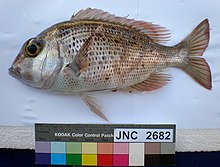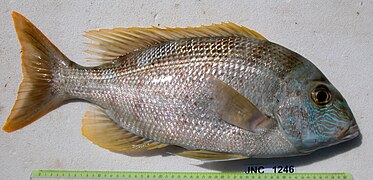Gymnocranius
| Gymnocranius | |
|---|---|

| |
| Gymnocranius euanus | |
| Scientific classification | |
| Domain: | Eukaryota |
| Kingdom: | Animalia |
| Phylum: | Chordata |
| Class: | Actinopterygii |
| Order: | Spariformes |
| Family: | Lethrinidae |
| Genus: | Gymnocranius Klunzinger, 1870[1] |
| Type species | |
| Dentex rivulatus | |
| Synonyms[1] | |
| |
Gymnocranius is a
Taxonomy
Gymnocranius was first proposed as a
Etymology
Gymnocranius means "naked skull" and it was originally a subgeneus of Dentex distinguished by having no scales on the crown.[5]
Species
There are currently eleven recognized species in this genus, but more species are awaiting description.[6]
- Gymnocranius audleyi J. D. Ogilby, 1916 (Collar Seabream)
- Gymnocranius elongatus Senta, 1973 (Forktail large-eye bream)
- Gymnocranius euanus (Günther, 1879) (Japanese large-eye bream)
- Gymnocranius frenatus Bleeker, 1873 (Yellowsnout large-eye bream)
- Gymnocranius grandoculis (Valenciennes, 1830) (Robinson's Seabream)
- Gymnocranius griseus (Temminck & Schlegel, 1843) (Grey Sea bream)
- Gymnocranius microdon (Bleeker, 1851) (Blue-spotted Seabream)
- Gymnocranius obesus W. J. Chen, Miki & Borsa, 2017 (Obese large-eye bream)
- Gymnocranius oblongus Borsa, Béarez & W. J. Chen, 2010 (Oblong large-eye bream)
- Gymnocranius satoi Borsa, Béarez, Paijo & W. J. Chen, 2013 (Sato's large-eye bream)
- Gymnocranius superciliosus Borsa, Béarez, Paijo & W. J. Chen, 2013 (Eyebrowed large-eye bream)
Characteristics
Gymoncranius fishes are medium to large breams, have oval shaped, laterally compressed bodies with a convex profile in front of the eye and a steeply sloping snout. In adults there is frequently a bony ridge on the nape and a bony shelf above the front of the eye.
Distribution and habitat
Gymnocranius emperors are found in the Indo-West Pacific from the coast of eastern Africa[8] and the Indian Ocean to the western and central Pacific Ocean. They are typically found in waters between 10 and 80 m (33 and 262 ft) deep over substrates of sand or rubble on continental coasts, although some species can be found off islands.[7]
Biology
Gymnocranius emperors are normally solitary, although one species G. griseus.. aggregates in schools. They are predators of benthic invertebrates.[7]
References
- ^ a b c d Eschmeyer, William N.; Fricke, Ron & van der Laan, Richard (eds.). "Genera in the family Lethrinidae". Catalog of Fishes. California Academy of Sciences. Retrieved 26 November 2023.
- ^ Froese, Rainer and Pauly, Daniel, eds. (2013). Species of Gymnocranius in FishBase. December 2013 version.
- ^ Eschmeyer, William N.; Fricke, Ron & van der Laan, Richard (eds.). "Species in the genus Gymnocranius". Catalog of Fishes. California Academy of Sciences. Retrieved 27 November 2023.
- OL 25909650M.
- ^ "Order SPARIFORMES: Families LETHRINIDAE, NEMIPTERIDAE and SPARIDAE". The ETYFish Project Fish Name Etymology Database. Christopher Scharpf. 17 October 2022. Retrieved 27 November 2023.
- PMID 28967518.
- ^ a b c d Kent E. Carpenter; Gerald R. Allen (1989). Emperor fishes and large-eye breams of the world (Family Lethrinidae). An annotated and illustrated catalogue of lethrinid species known to date (PDF). FAO Species Catalogue. Vol. 9. FAO, Rome. pp. 18–19.
- ^ ISBN 978-1-990951-32-9.
- ^ Froese, Rainer and Pauly, Daniel, eds. (2023). Species of Gymnocranius in FishBase. October 2023 version.






